Seven things you might not know about Brick Lane
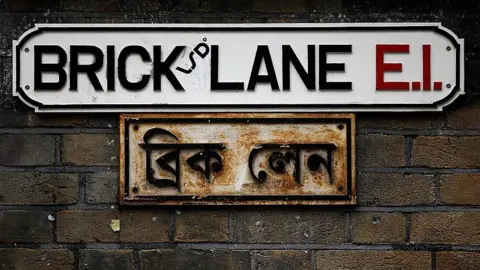 Getty Images
Getty ImagesBrick Lane in London's East End could become pedestrianised in an effort to cut down on traffic fumes, allow outdoor dining and give its 19,000 daily visitors a bit more room in which to view the menu of their curry house of choice.
Snaking from Bethnal Green towards Whitechapel, Brick Lane - the name making it easy to guess its origins as a place of brick and tile-making - is now best known for being the centre of London's Bangladeshi-Sylheti community and the associated authentic and highly rated food.
It has been through many incarnations since the 1550s, when it was first identified in a survey of the Manor of Stepney, and the area has long been something of a haven for those looking for a better life.
Huguenots arrived after being driven out of France in the 17th Century, many bringing their skills and setting up as weavers and drapers. In the 19th Century Jewish people escaping pogroms in the Russian Empire flocked here, as did Irish people looking for work. The previous lives of Brick Lane Mosque indicate this shifting demographic - a Huguenot chapel which became a Methodist church, which became a synagogue.
The area has had its fair share of trouble. A number of people were injured in 1999 when a nail bomb was detonated in a racist attack, while in 2015 anti-gentrification protesters attacked a café specialising in cereal.
In 2003, the novel Brick Lane by Monica Ali was published to widespread acclaim - but also to consternation over its portrayal of the Bangladeshi-Sylheti community. Feelings were still running high enough three years later that the makers of the film version of the book gave up trying to shoot scenes in Brick Lane.
BBC News has compiled some of the less well-documented goings on in this corner of the capital that might have escaped your attention.
Lion cub for sale
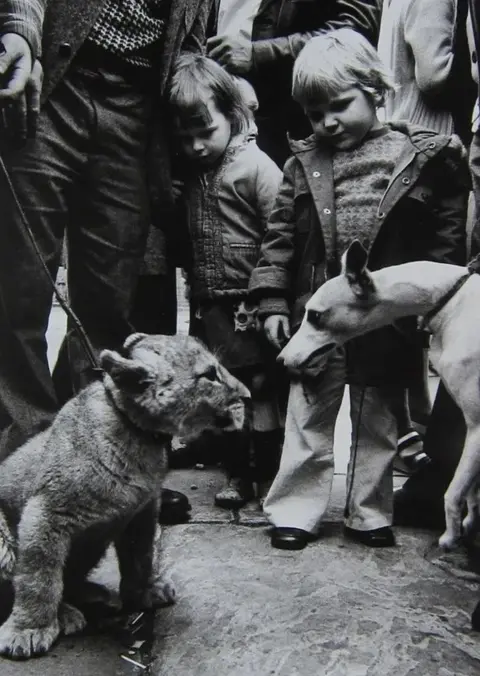 Markéta Luskačová
Markéta Luskačová For 30-odd years from the 1950s, an animal market used to run in Club Row, just off Brick Lane, with caged birds covering almost every wall and puppies being sold alongside goats, snakes and monkeys.
Czechoslovakian photographer Markéta Luskačová also famously captured an image of a lion cub for sale.
She remembered that the price dropped over successive weeks as the cub grew and became more dangerous. Eventually, the vendor swapped the King of the Jungle for a tray of watches.
The RSPCA closed the market down in the 1980s and a law amended in 1983 banned the street sale of animals altogether.
Peeled and preserved human corpses
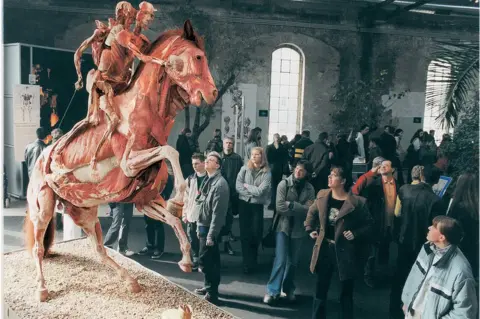 Getty Images
Getty ImagesAn exhibition called Body Worlds came to the UK in 2002, setting up at a gallery in Brick Lane.
Prof Gunther von Hagens (always seen wearing a hat) developed a system of "plastination" to preserve real remains, "providing unique insights into the healthy and diseased human body". He first came to British attention by performing a post-mortem examination live on Channel 4.
Then the exhibition of actual corpses, flayed and posed as if enjoying various recreational pursuits (playing chess, reading a newspaper, riding a horse while holding aloft a brain) came to town.
A sort of cross between an anatomy textbook come to life and a Victorian freak show, it attracted criticism and tourists, with long queues forming outside the Atlantis Gallery from the early hours of each day.
There is now a permanent exhibition in London at the former site of Ripley's Believe It or Not! in Piccadilly Circus.
Gambling and jealousy
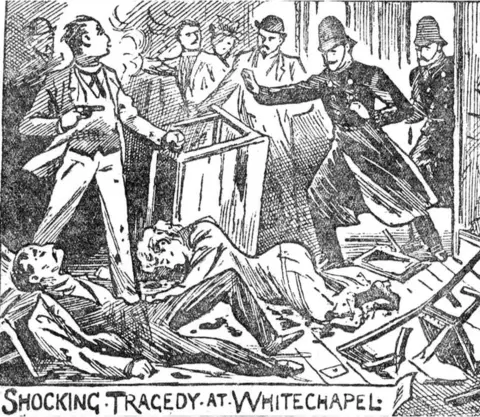 Illustrated Police News
Illustrated Police NewsSpecialising in thrilling tales of criminal depravity recounted in a breathless yet oddly judgemental manner, the Illustrated Police News carried the story of "A Shocking Tragedy" in early 1898.
A man and woman were shot dead at a Polish restaurant in Brick Lane - and the woman was believed to be married but living apart from her husband. The paper qualifies this outrageous allegation with: "Of this the police have at present no evidence beyond the fact that after the tragedy - for she was one of the unfortunate victims - a wedding ring was found in the pocket of her dress."
Only after the wedding ring revelation do we move on to the "blood-bespattered" crime scene.
"A crowd collected with the celerity characteristic of the denizens of the East End, and soon afterwards a number of police officers were on the scene. An entry to the premises was effected, and then an appalling sight presented itself to the representatives of the law.
"On the floor lay a woman weltering in blood, and not far distant from her was a man whose life was evidently ebbing quickly away.
"Confusion reigned supreme."
It's also worth a mention that the armed murderer was "a tall, respectably-dressed man".
The crime was eventually explained by "gambling and jealousy". The tall man, despite his respectable dress, was jailed for 10 years for manslaughter.
Puffed-up prices for poultry
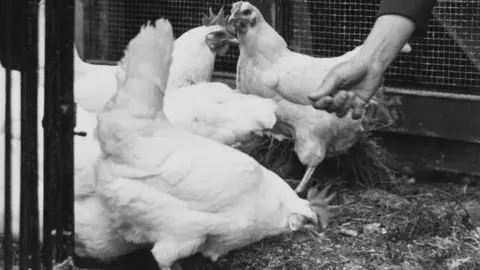 Getty Images
Getty ImagesIn January 1945, Britain was hungry. Still seven months away from the end of World War Two, meat was scarce - and, as such, had a government-imposed price. The issue was brought to the attention of the House of Commons in an incredibly specific way.
Hansard records that Major Morris asked the then Minister of Food, Colonel Llewellin, "if he is aware that on 19 December Messrs Morgan & Company, Poulterers, Brick Lane, London, E.C., charged £1 12s [approximately £60 today] for a chicken weighing 3¾ pounds which was required for a woman seriously ill after confinement; and what action he proposes to take in the matter?"
Col Llewellin was not aware but said he would "cause immediate inquiries to be made".
'Mad' Frankie Fraser's one-man show
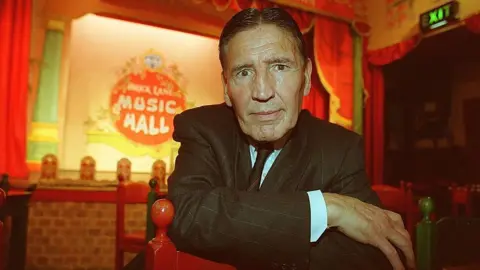 Getty Images
Getty ImagesA gangster who spent 42 years locked up in either prisons or secure hospitals, Frankie Fraser was better known for torturing his victims by pulling their teeth out with pliers than entertaining the crowds with a couple of amusing anecdotes.
But time is a great sanitiser, and this violent man who avoided wartime service in favour of looting bombed buildings, toured the country with his show, An Evening with Frankie Fraser.
He launched his celebrity career at the Brick Lane Music Hall, and later supplemented his income by running so-called "gangland tours", the itinerary of which included whistle-stop visits to where the Krays were arrested, the road Jack the Hat was murdered, the pub where George Cornell was shot, "then a stop for a drink and sandwiches".
Topics included court cases, crime, prison, Broadmoor, violence, the justice system, and other gangsters.
Russian vapour baths
 Getty Images
Getty ImagesAccording to the Jewish Museum, the Russian Vapour Baths in Brick Lane were more popularly known as "Schewzik's", after their owner Benjamin Schewzik.
The steam baths were used by the large immigrant Jewish community living in London's East End from the late 19th Century and were especially popular with men finishing work on a Friday evening, before going to the synagogue for prayers.
Nearby shops also had a Jewish flavour, with a salt beef and provisions shop and a Rosenburg's jeweller next door.
Posters and newspapers were printed in Yiddish and a Sunday market was allowed by special governmental dispensation, as the usual day for markets in England was a Saturday - meaning those observing the Sabbath on a Saturday would be unable to buy goods.
 The Jewish Museum
The Jewish MuseumPet Shop Boys
 Getty Images
Getty ImagesNeil Tennant's lyrics to Brick England, describing an urban landscape and the cyclic nature of cities, are an unusual mix of classic literature and humdrum street signage.
In the Pet Shop Boys fan publication Literally, Tennant described his moment of inspiration: "I was walking up Brick Lane in the East End of London, and there was a sign saying 'road closed diversion' and that went into the song as well.
"It's about how cities come and go."
Brick Lane
In the rain
Road closed
Diversion
A snake of tourists
Meandering
Under grey clouds
In Brick England.
And a passage from the Charles Dickens novel Hard Times: "She sat at the window, when the sun began to sink behind the smoke; she sat there, when the smoke was burning red, when the colour faded from it, when darkness seemed to rise slowly out of the ground, and creep upward, upward, up to the house-tops, up the church steeple, up to the summits of the factory chimneys, up to the sky" sparked the lyrics:
Evening
When the sun begins to sink
Behind the smoke
There's a burning red glow all around
Watching
As the colour starts to fade
And the darkness
Seems to rise out of the ground.
And so, from pet market lions to Pet Shop Boys, taking in Russian vapours, Mad Frankie's capers, sensationalist papers, Huguenot drapers, poultry-price inflaters and flayed-corpse shapers, Brick Lane's next manifestation as a walker-friendly al fresco dining hub is simply the continuation of its cycle of birth and rebirth.
